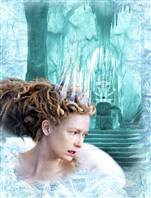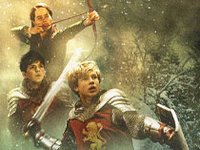experiencing narnia
Today I'm combining with the critics to give a review of Narnia, though I saw it a few weeks ago. There may be spoilers, so perhaps skip this post if you haven't seen the movie yet (and are not already aware of how the story goes).
 Narnia movie pleases critics
Narnia movie pleases criticsDec 8 (I saw Narnia when it opened in Australia on Dec 26)
The Chronicles of Narnia: The Lion, the Witch and the Wardrobe opens on Friday in North America and widely in Europe in what the Walt Disney Co and Walden Media hope will be the first of a series based on Lewis' seven books.
Television's Ebert & Roeper praised the cutting-edge special effects and called it "a fantasy that has charm ... beauty and enchantment."
...but the lush detail of the world of Narnia and the look of its characters sprang mainly from the imagination of director Andrew Adamson, who read the books as a child...Walden Films and the Walt Disney Co spent a year perfecting the groundbreaking special effects to produce realistic creatures to interact seamlessly with the children.
There was a lot of room for invention in Lewis' loosely written 1950 novel.
Adamson said he was surprised that the detailed battle scene he loved as a child occupied only a page in the book.
"I didn't want to make the book as it was, I wanted to make the book as I remembered it," Adamson said.
 Me: Visually, Narnia was wonderful. Snowscapes straight off a Christmas card, sweeping battlefields, all kinds of mythical creatures as well as very convincing speaking animals. Some aspects of the movie were deliberately mild ~ it could have been a lot more intense and graphic, especially the battle scenes and the death of Aslan, but they held back. One part of me felt a little let down - I wanted this movie to sweep me away emotionally like it did when I was a child. However I was glad in the end that they didn't go down that road.
Me: Visually, Narnia was wonderful. Snowscapes straight off a Christmas card, sweeping battlefields, all kinds of mythical creatures as well as very convincing speaking animals. Some aspects of the movie were deliberately mild ~ it could have been a lot more intense and graphic, especially the battle scenes and the death of Aslan, but they held back. One part of me felt a little let down - I wanted this movie to sweep me away emotionally like it did when I was a child. However I was glad in the end that they didn't go down that road.  I don't have the imagination now that I had at 9; but the 9-year-olds in the audience do. Children don't need to see a death happen - that knife slashing through the air is all their imagination needs to construct the whole thing in their mind. It was enough if you want to preserve the sense and feeling of a children's story.
I don't have the imagination now that I had at 9; but the 9-year-olds in the audience do. Children don't need to see a death happen - that knife slashing through the air is all their imagination needs to construct the whole thing in their mind. It was enough if you want to preserve the sense and feeling of a children's story.And it certainly did that. All the way through it was pure fairytale, yet it didn't have that false feeling of pantomine that some fairy tale movies have. I do wish they'd spent a little more time showing the children getting to know Aslan. His death was upsetting, but we hadn't had much time to grow to love him when it happened.
Adamson, who directed the animated hits Shrek and Shrek 2, spent 18 months searching for four "real kids" to star in his first-ever film directing real human beings.
 Me: The children were well cast, especially Georgie Henley (Lucy). She goes through the full range of emotions in this movie and even has a good sense of comedic timing. The scene where Lucy first visits Mr Tumnus and he admits that he is trying to kidnap her is amazing. She is trying to comfort him and suddenly she understands her danger. Her voice is so full of hurt and confusion when she says, "I thought you were my friend." Wonderful stuff.
Me: The children were well cast, especially Georgie Henley (Lucy). She goes through the full range of emotions in this movie and even has a good sense of comedic timing. The scene where Lucy first visits Mr Tumnus and he admits that he is trying to kidnap her is amazing. She is trying to comfort him and suddenly she understands her danger. Her voice is so full of hurt and confusion when she says, "I thought you were my friend." Wonderful stuff. Generally, too, they were very 'real'. It was a good contrast to the very unreal inhabitants of Narnia. This was especially hard to pull off in the case of the witch. She is supposedly the daughter of Lillith (who some religions believe was Adam's first wife) and a giant. Obviously her form is like a human, and so they needed to make her not quite so - a little unearthly and unnatural. This was evident in both her makeup and her costuming. The necklines of her dresses for example, sat out too far forward from her body in an odd, purposeless way.
Generally, too, they were very 'real'. It was a good contrast to the very unreal inhabitants of Narnia. This was especially hard to pull off in the case of the witch. She is supposedly the daughter of Lillith (who some religions believe was Adam's first wife) and a giant. Obviously her form is like a human, and so they needed to make her not quite so - a little unearthly and unnatural. This was evident in both her makeup and her costuming. The necklines of her dresses for example, sat out too far forward from her body in an odd, purposeless way. It's taken half a century for the Chronicles of Narnia, one of the best-loved children's series to hit the big screen but positive early reviews indicate the old fashioned yarn made the journey safely. Los Angeles Times reviewer Carina Chocano described the film as "real by the logic of childhood" and noted that the book's much-discussed Christian themes do not overwhelm the simple tale of four children's adventures in Narnia.Me: When I was about 9 or 10 I read the Narnia series all the way through. It captured my imagination and emotions. When I meet someone who hasn't read the series, I usually recommend that they do, but I always feel it's a shame they missed out on reading it as a child. It's a child's book, written for a child, about a world that is everything a child dreams about: beautiful, full of interesting characters, and having a story that lets them be the adventurous hero(ine).
"As a Christian primer, it's terrible. As a story, it's timeless," Chocano wrote in a review on Wednesday.
Most of the time in life, kids are on the sidelines. You're rarely the centre of attention (birthdays, recitals, grand finals and serious illness excepted) and you never have all the information or get to make the big decisions. Most of the time you're "not old enough" or sitting at "the kids' table" or being shuffled out of the room the moment anything really interesting or meaningful is happening or being discussed. The Chronicles of Narnia may be an "old-fashioned yarn" (and the assumption of human supremacy over every other kind of species alone makes it so ~ that's much more unusual to see in stories nowadays) but it puts the children front and centre. They are not only special just by nature of being who they are, but importantly they are also compelled by their own sense of right to reach deep inside themselves and do and become more than they ever thought possible. Initially their reaction is predictable: "but we're children! we can't do that ~ we're not brave enough or skilled enough or experienced enough. But all that changes.
Me: I know that the Lion, the Witch and the Wardrobe eventually developed into CS Lewis' allegory of the atonement of Christ, but I never saw or understood those themes when I was 9 (except perhaps the idea that we can be forgiven when we make mistakes.) What I did understand though, and what I think is (whether Christian or not) the most important message of the book is that you are never too young, or too inexperienced, to do what you think is right; the question always boils down to simply whether or not you are brave enough. Lucy knows that Mr Tumnus has been taken prisoner because he supported her instead of betraying her. In spite of Susan's very sensible arguments that they are not safe in Narnia, and ill-equipped as they are to fight the witch or even know who to trust, Lucy stands firm that the right thing to do is try and help Tumnus, no matter what the consequences. And they all know it's so; they just need the courage to act on their convictions.Lewis once said that the idea for the Chronicles of Narnia began not with an intention to write Christian fables, but with the images of a faun carrying an umbrella, a queen on a sledge and a magnificent lion.
"At first there wasn't anything Christian about them. That element pushed itself in of its own accord," he wrote.
 Bear in mind this story is set in World War II, and these British children had very real, very cruel and powerful, enemies outside the wardrobe, too. Sent to the country to stay safe while adults fought without them and decided their future, they found a world inside the wardrobe where they are the deciding factor. And eventually they realise that this fight is real and important, and that some things are worth fighting against, no matter what the cost.
Bear in mind this story is set in World War II, and these British children had very real, very cruel and powerful, enemies outside the wardrobe, too. Sent to the country to stay safe while adults fought without them and decided their future, they found a world inside the wardrobe where they are the deciding factor. And eventually they realise that this fight is real and important, and that some things are worth fighting against, no matter what the cost.  This is taken to a whole other level when Aslan sacrifices himself to save Edmund, a wretched sneak who's betrayed them all in the worst way. But Edmund isn't their enemy in the same way that the Witch is. Aslan doesn't just save Edmund life's ~ he also gives him a clean slate and restores him to his family.
This is taken to a whole other level when Aslan sacrifices himself to save Edmund, a wretched sneak who's betrayed them all in the worst way. But Edmund isn't their enemy in the same way that the Witch is. Aslan doesn't just save Edmund life's ~ he also gives him a clean slate and restores him to his family.I may not have recognised the Christian themes in Narnia when I read it as a 9-year-old, but I appreciate them now. It's not a perfect allegory, and chances are it was never intended to be, but there are some deep and beautiful concepts portrayed ~ in particular the way the Atonement (symbolised by Aslan's sacrifice) balances the demands of both Justice and Mercy.
[For anyone interested in discussion on the Christian elements in Narnia, Q has posted some interesting related questions over at Ragged Glory.]

<< Home